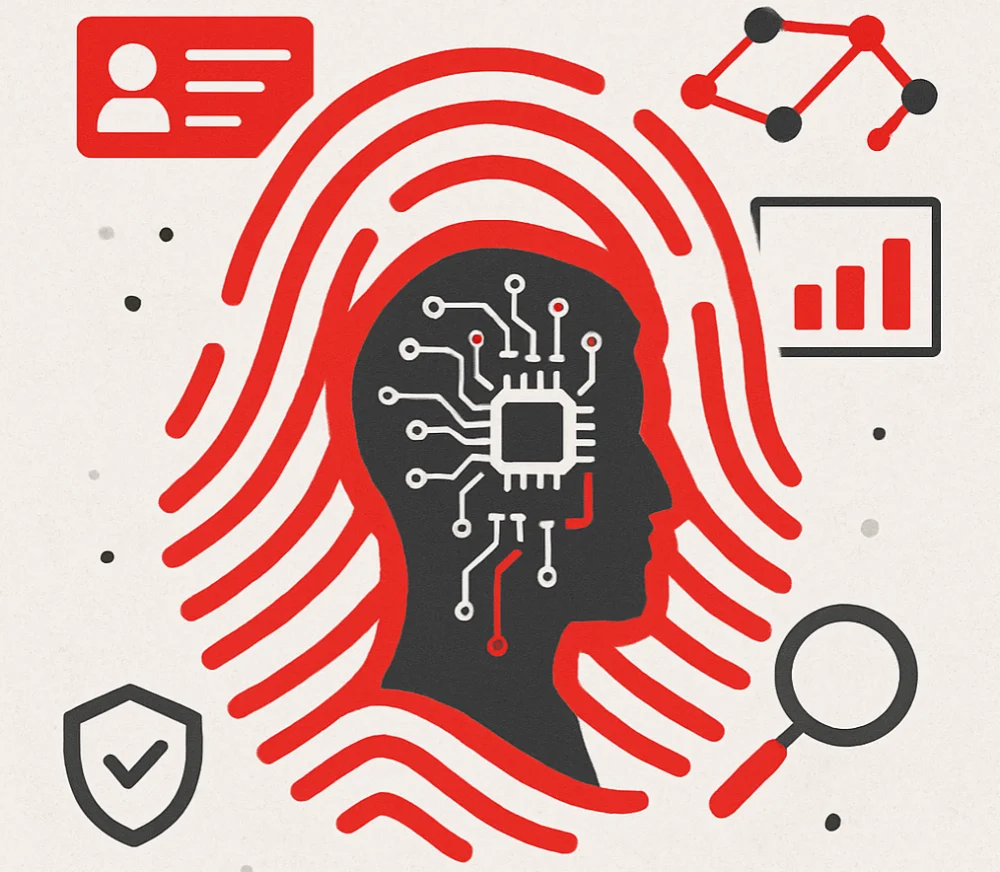Understanding who’s behind digital activity can shift the direction of an investigation. That’s the essence of identity intelligence: the process of collecting, enriching, and analyzing identifiers such as usernames, email addresses, and phone numbers to reveal real-world actors.
With threats becoming more sophisticated and anonymous, identity intelligence has emerged as a crucial additional layer of threat intelligence to help teams operate with greater speed, depth, and confidence.
In this article, we’ll break down what identity intelligence is, how it can be used, the techniques involved, and the value it can provide to your investigations.
What is Identity Intelligence?

Identity intelligence is the process of collecting, analyzing, and correlating online identifiers to expose real-world identities and hidden relations behind digital activity. It connects the dots between surface data, potential aliases (names, usernames, email addresses, IPs, etc.), behavior, group membership, intent, and real identities.
Identity intelligence plays a critical role in attribution, especially when threat actors attempt to mask their identities. By correlating aliases, infrastructure, and behavior across disparate data sources, it helps analysts assemble a clearer picture of the person behind the proxy, screen name, or credential.
Identity intelligence also plays a key role in fraud detection, such as identifying account takeovers, fraudulent personas, and synthetic identities based on weak signals, reused attributes, and other indicators. Law enforcement and private-sector cyber incident investigations can also leverage identity intelligence to accelerate casework, narrow down suspect pools, and uncover actionable leads based on verifiable digital evidence.
The process often starts with a single identifier, such as an alias, an email, a phone number, or an IP address. This data can be correlated with breach data, social media handles, domain registrations, dark web forums, messaging apps, web app trackers, and more.
Device IDs, MAC addresses, metadata, and other user behavior signals can provide additional context. When these disparate signals are stitched together properly, they create a digital fingerprint of an individual or group that’s strong enough for attribution, target profiling, or criminal network disruption.
Techniques Used in Identity Intelligence

Effective identity intelligence relies on smart techniques that turn disparate identifiers into actionable insight. Here are some of the common methods investigators employ to uncover the people behind the activity.
Identifier Correlation
Correlation looks for relationships between usernames, email addresses, phone numbers, IP addresses, device IDs, and other data sources. While many threat actors work hard to isolate their identities from one another across services, there are almost always overlaps somewhere, such as identical aliases, passwords, handles, recovery email addresses, associated infrastructure, and other clues that can be correlated to help establish continuity and make connections across digital activities.
Data Enrichment
Enrichment adds context by associating identifiers with third-party data sources (breach dumps, email header metadata, domain WHOIS records, open social profiles, etc.). This can often help confirm attributes (e.g., location, likely real name, other interests) or uncover related data (e.g., associated passwords, exposed login credentials, similar accounts, co-used IP addresses).
For example, enriching an email address exposed in a breach might turn up associated passwords, linked accounts, or IP addresses. A phone number might lead investigators to profiles on encrypted messaging apps or peer-to-peer marketplaces.
Behavioral Analysis
Identifying activity patterns is key in many investigations. Habits and preferences, such as time zones, language, geolocations, dialect, slang, the specific days or times used to login, or even preferred software or tactics, can help build a unique signature around a group or individual.
Behavioral analysis can also help determine whether an activity is likely human or automated, or to differentiate between one actor and another sharing the same infrastructure.
Digital Footprinting
Footprinting involves mapping an individual’s or group’s activity and presence across the web. This can include activity on forums, social media sites, gaming platforms, review platforms, paste sites, cryptocurrency forums, hacking sites, and dark web marketplaces.
Investigators look for signs of where and how an identity has engaged across these platforms, looking for consistencies in writing style, activities, stated habits, and affiliations that can strengthen attribution or indicate intent.
Pivoting for Context
Investigators will often use related identifiers to build out their investigation from the initial data point. For example, a known email address might uncover a matching username, which appears on a forum. That forum post may contain links to other relevant accounts or data sources.
Pivoting, or moving laterally from one data point to another, helps investigators expand their context, validate connections between data points, and avoid confirmation bias.
Automated and Manual Investigations
Automation enables investigators to scan billions of records and map identity networks far faster than manual analysis. However, human judgment is critical to interpret nuance, verify context, and spot false positives. The best workflows blend machine speed with human expertise to strike a balance between scale and precision.
These techniques enable investigators to cut through layers of obfuscation and build a clear picture of the individual or group behind specific actions.
Benefits of Identity Intelligence

Identity intelligence gives investigative teams a clearer view into the identities behind online activity, eliminating a lot of the unknowns in the loop between detection and response. Armed with more and better information about who is behind a signal, you can respond more quickly and confidently, focusing on the highest-value efforts.
Faster and More Accurate Attribution
Attribution improves when analysts can quickly connect usernames, emails, breach records, and behavioral patterns to a real identity. Identity intelligence accelerates this process by turning scattered signals into concrete links in seconds, not hours, enabling teams to respond while the threat is still unfolding.
Improved Decision-Making in Investigations
High-resolution identity data helps you see the bigger picture. When you’re in the middle of an investigation, considering whether to escalate, pivot, at a dead end or close a case, knowing who you’re dealing with can be the factor that shifts your decision in one direction or another.
Enhanced Fraud Detection and Response
Fraud actors often reuse digital identifiers across campaigns. Identity intelligence helps detect recycled handles, phone numbers, and credentials linked to known fraud patterns, enabling faster detection and proactive response before the damage spreads.
Stronger Insider Threat Detection
Insider threats are harder to detect when activity is masked by secondary accounts or anonymized behavior. Identity intelligence links digital actions to real-world identities, making it easier to spot anomalies, uncover misuse, and expose insiders operating behind burner accounts or suspicious access patterns.
Better Prioritization of Threats through Identity Attribution
Security teams should prioritize cases where identities are linked to higher-risk behavior. By linking individuals or indicators of compromise (IOCs) to known threat actors, resellers, personas, etc., teams can focus on signals that have a higher likelihood of real-world impact.
Reduced Dwell Time in Threat Response
Every minute counts in incident response. When identity context is at your fingertips, you cut down the time it takes to investigate, confirm, and act. That means less time spent hunting and more time responding.
Real-World Applications of Identity Intelligence

Identity intelligence isn’t confined to a specific vertical or mission. At the core of any identity intelligence investigation is a need to better understand who is behind a given set of digital artifacts. These may lead to an organizational pivot or inform a high-stakes case outcome.
Law Enforcement
Law enforcement and intelligence analysts employ identity intelligence techniques to connect digital screen names or aliases to real-world identities in cases involving cybercrime, financial fraud, human trafficking, terrorism, and other criminal or national security investigations. Every minute counts in these investigations, and finding that one alias that ties together an email address or breach record, a criminal complaint, or an active participant in an online forum can be the difference between a successful investigation and a cold case.
Corporate Security and Insider Threat Prevention
Corporate security analysts correlate potentially suspicious activity inside an enterprise network against identity signals to support early detection and remediation capabilities. With identity intelligence, it’s possible to detect indicators that an employee is planning to exfiltrate company data through personal email accounts or that an insider is accessing customer support systems outside of normal business hours.
Learn more about corporate security.
Brand Protection and Fraud Detection
Brand protection and fraud analysts work to mitigate risks tied to identity abuse, such as disinformation campaigns, phishing attacks, social media impersonations, and other fraud attacks. Identity intelligence enables these investigators to surface real actors behind collections of fake domains, email accounts, cloned social profiles, and phishing kits to better understand the threat actor behind a current campaign, as well as related campaigns they may have already launched.
National Security and Intelligence
National security analysts and intelligence professionals leverage identity intelligence as part of their investigative process. Aggregators, researchers, or human analysts can connect pieces of evidence found in forums, across social media, and even encrypted channels to uncover links to extremist networks, influence operations, or state-sponsored activity. One identifier within a compromised device can surface an entire network when cross-referenced against large datasets.
Journalism and Research
Journalists and researchers can also benefit from having a comprehensive view of the identities within their scope of interest. Investigative journalists can use these techniques to unmask online bot operators, reveal real-world actors behind a coordinated disinformation campaign, or connect online activity to actual people, places, and entities.
Types of Identity Intelligence Tools

Identity intelligence tools live at the nexus of attribution, investigation, and analysis. The goal with these tools is to enrich an identifier or set of identifiers (emails, usernames, phone numbers, etc.) with as much context as possible to link the digital identity elements to an actual physical identity.
Some tools focus on correlation and enrichment, some on graphing and visualizing networks, and some are better at tracking digital behavior across social media or open-source intelligence (OSINT) sources. These tools fall into five main categories:
- Identity Resolution Platforms connect emails, usernames, and phone numbers to real-world data for attribution and fraud investigations (Horizon™ Identity, Pipl, Tracers).
- Social Media and OSINT Tools map online behavior and public profiles to track aliases and networks (SocialNet).
- Breach and Credential Tools expose compromised identifiers in leaks and dumps to assess risk or attribute activity to specific threat actors (HaveIBeenPwned, Dehashed, Intelligence X).
- Behavioral Analysis Tools analyze time zones, writing style, and other patterns to identify shared operators or sock puppets (Hunchly, IntelTechniques).
- Graphing and Pivoting Tools visualize connections between identifiers and infrastructure for deeper investigations (Linkurious, ShadowDragon Horizon™).
The right tool stack for your needs will depend on your mission, how deep you need to go, and how your team is set up.
Final Thoughts
Digital artifacts are everywhere, but without context, they’re just noise. Turning them into intelligence starts with identity attribution. Whether for cybercrime, insider threats, financial crime, or influence operations, analysts need tools that will rapidly and accurately collect, connect dots and analyze between the online world and its real-world actors.
Horizon™ Identity by ShadowDragon is designed to do just that. Input one data point, such as an email, username, or phone number, and Horizon™ Identity instantly correlates it to over 550 public sources, more than 15 billion breach records, and more than 1,500 endpoints to build high-fidelity identity profiles that can dramatically reduce your investigation time and make attribution possible.
In a world where adversaries are moving fast and covering their tracks better than ever, Horizon™ Identity is giving analysts the context, coverage, and confidence to make mission-critical decisions. Contact us for a demo to learn more about how Horizon™ Identity can enhance your investigations.





